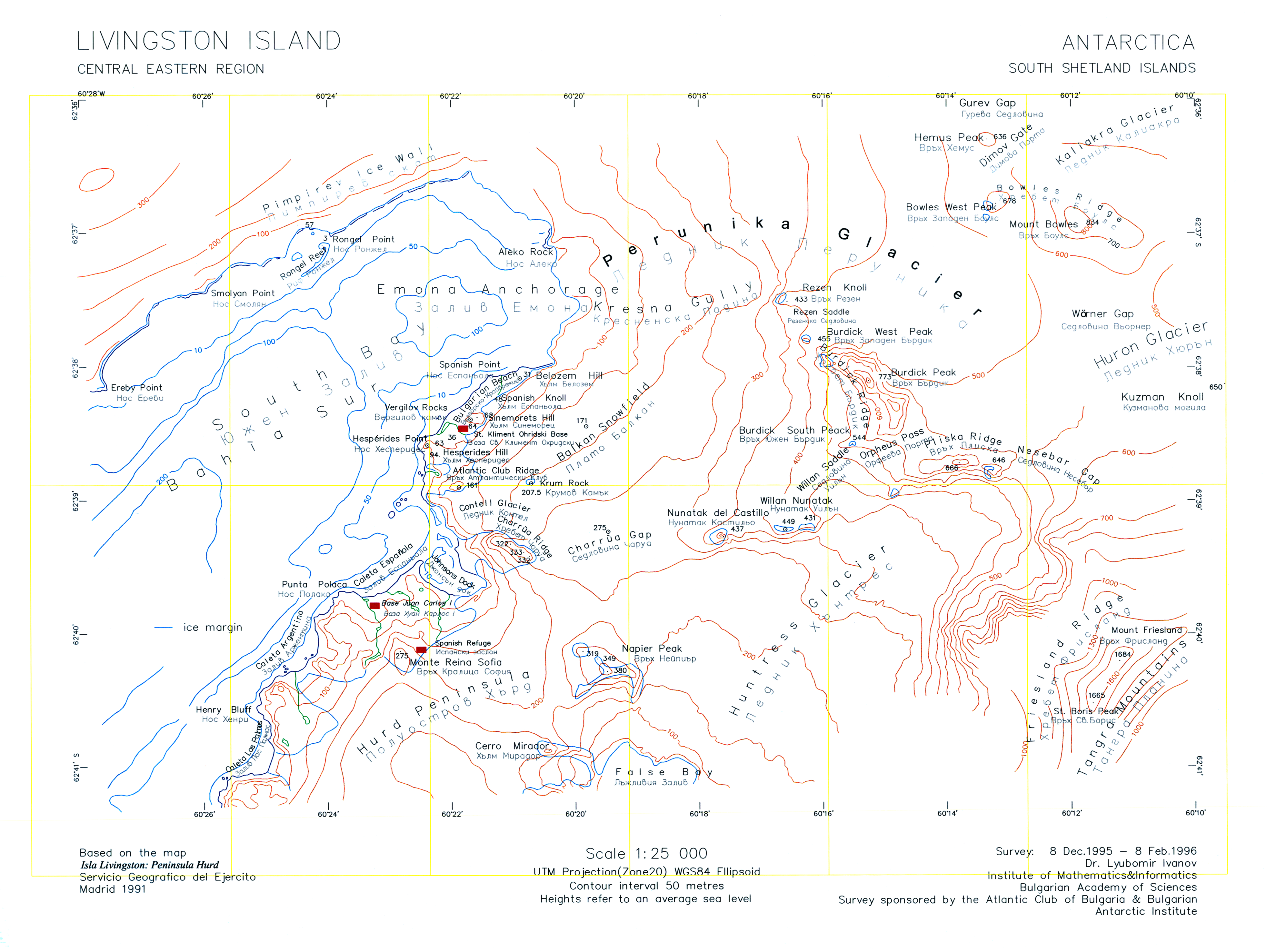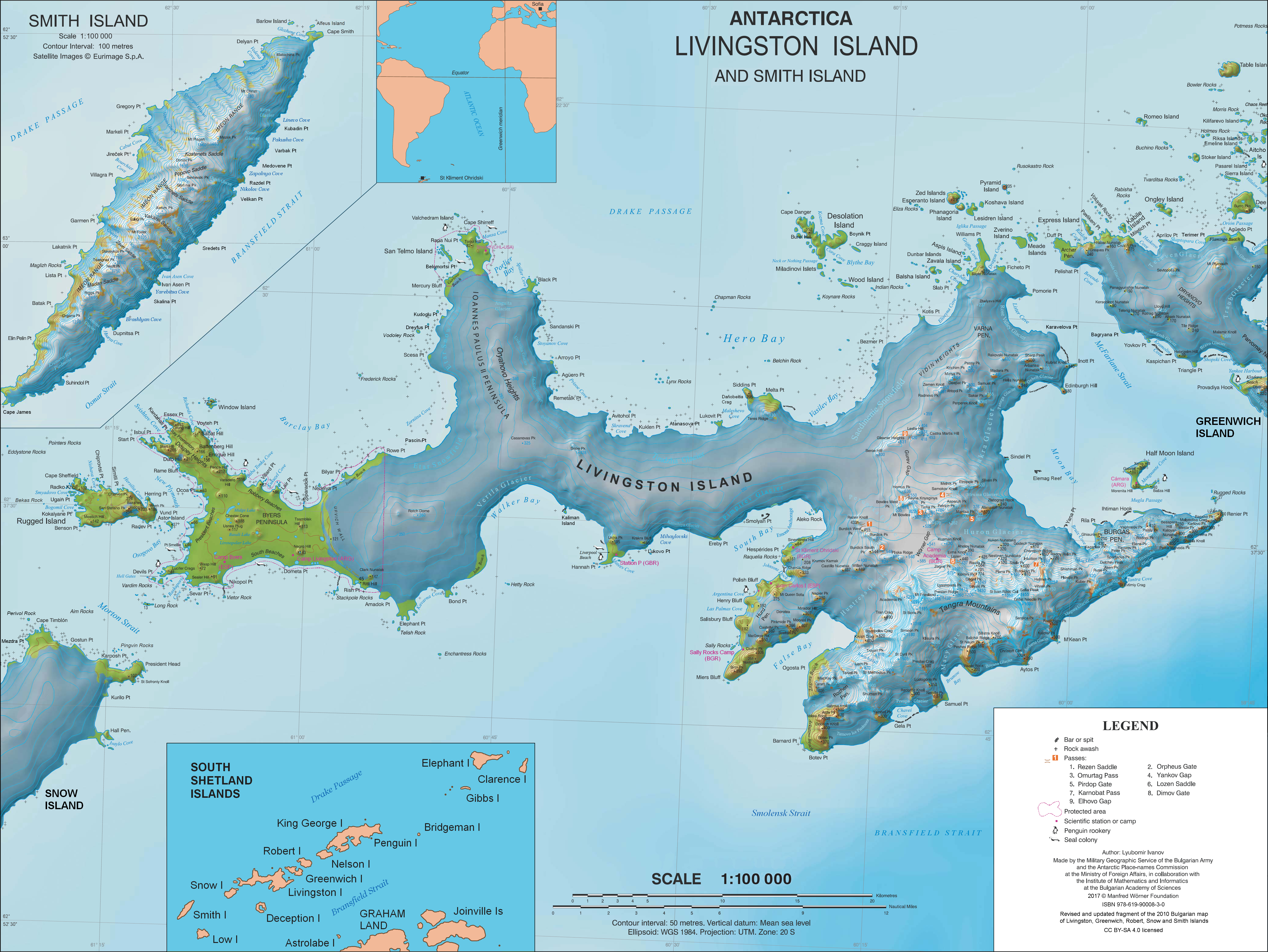|
Sinemorets Hill
Sinemorets Hill (Halm Sinemorets \'h&lm si-ne-'mo-rets\) is the second most prominent (after Hesperides Hill) in the chain of hills surmounting Bulgarian Beach in eastern Livingston Island in the South Shetland Islands, Antarctica. Sinemorets Hill is 380 m long in east-west direction and 230 m wide, with twin heights, the west-southwestern one being 64 m and the east-northeastern one 62 m, sheltering a small pool between them. It is snow free in the summer months and overlooks the Bulgarian base to the southwest. Relics of an old encampment were still discernible at its eastern slope in 1996. Sinemorets is the name of a village and a cape on the Black Sea coast. The hill was named by the United Kingdom Antarctic Place-Names Committee (UK-APC) in 1994 at the request of the Second Bulgarian Antarctic Expedition (1993/94). Location The peak is located at , which is 820 m east-northeast of Hespérides Point, 220 m inland from Greenpeace Rock, 1.2 km northwest of Krum Ro ... [...More Info...] [...Related Items...] OR: [Wikipedia] [Google] [Baidu] |
United Kingdom Antarctic Place-Names Committee
The UK Antarctic Place-Names Committee (or UK-APC) is a United Kingdom government committee, part of the Foreign and Commonwealth Office, responsible for recommending names of geographical locations within the British Antarctic Territory (BAT) and the South Georgia and the South Sandwich Islands (SGSSI). Such names are formally approved by the Commissioners of the BAT and SGSSI respectively and published in the BAT Gazetteer and the SGSSI Gazetteer maintained by the Committee. The BAT names are also published in the international Composite Gazetteer of Antarctica maintained by SCAR. The Committee may also consider proposals for new place names for geographical features in areas of Antarctica outside BAT and SGSSI, which are referred to other Antarctic place-naming authorities or decided by the Committee itself if situated in the unclaimed sector of Antarctica. Names attributed by the committee * Anvil Crag, named for descriptive features *Anckorn Nunataks, named after J. F. Anck ... [...More Info...] [...Related Items...] OR: [Wikipedia] [Google] [Baidu] |
Composite Antarctic Gazetteer
The Composite Gazetteer of Antarctica (CGA) of the Scientific Committee on Antarctic Research (SCAR) is the authoritative international gazetteer containing all Antarctic toponyms published in national gazetteers, plus basic information about those names and the relevant geographical features. The Gazetteer includes also parts of the International Hydrographic Organization (IHO) General Bathymetric Chart of the Oceans (GEBCO) gazetteer for under-sea features situated south of 60° south latitude. , the overall content of the CGA amounts to 37,893 geographic names for 19,803 features including some 500 features with two or more entirely different names, contributed by the following sources: {, class="wikitable sortable" ! Country ! Names , - , United States , 13,192 , - , United Kingdom , 5,040 , - , Russia , 4,808 , - , New Zealand , 2,597 , - , Australia , 2,551 , - , Argentina , 2,545 , - , Chile , 1,866 , - , Norway , 1,706 , - , Bulgaria , 1,450 , - , G ... [...More Info...] [...Related Items...] OR: [Wikipedia] [Google] [Baidu] |
Atlantic Club Ridge
The Atlantic Club Ridge (, ) is a ridge rising to 161 m on Hurd Peninsula in Eastern Livingston Island, Antarctica. To the west the ridge surmounts the South Bay coast north of Johnsons Dock, to the south it is bounded by the lower course of the two km long Contell Glacier, to the east by the foot of the Balkan Snowfield sloping up towards Krum Rock and to the northwest by Sea Lion Tarn. The ridge is snow-free in the summer months. The ridge's steep northern slopes are linked with Hesperides Hill by a saddle of 52 m elevation. The higher rocky ground on the Atlantic Club Ridge, as well as on the hills surmounting Bulgarian Beach, is noted for its abundant bushy-grown lichens, while moss and Antarctic hair-grass (''Deschampsia antarctica'') communities thrive on the guano-enriched soil on top of larger rocks at the seaward hill feet. In commemoration of the co-organizers of the 1993–94, 1994–95, and 1995–96 Bulgarian Antarctic campaigns the name Atlantic Club was ... [...More Info...] [...Related Items...] OR: [Wikipedia] [Google] [Baidu] |
Krum Rock
Krum Rock ( \'kru-mov 'ka-m&k\) is a small nunatak rising to 208 metres on the southwest edge of Balkan Snowfield just north of Contell Glacier on Hurd Peninsula in eastern Livingston Island, one of the South Shetland Islands in Western Antarctica. The rock projects slightly above the ice sheet with some 3,000 square metres of rocky ground exposed on its northern slope in summer. Because of its location rather than prominence, it is a particularly important landmark in the course of field work carried out in the area. Location The nunatak is located at which is 1 km east of Atlantic Club Ridge, 1.2 km southeast of Sinemorets Hill, 2.8 km west by north of Castillo Nunatak, and 1 km north by east of the highest point of Charrúa Ridge. Krum Rock is named for Krum Velchev, meteorologist at St. Kliment Ohridski Base for several seasons since 1993. The name form ''Krumov Kamak'' was well established in use at the time of approval. Maps Isla Livingston: Pení ... [...More Info...] [...Related Items...] OR: [Wikipedia] [Google] [Baidu] |
Hespérides Point
Hespérides Point () is a rocky point of land projecting into South Bay north-northwest of Johnsons Dock, Livingston Island in the South Shetland Islands, Antarctica and forming the southwest side of the entrance to Emona Anchorage. Surmounted by Hesperides Hill. The area was visited by 19th century sealers operating from nearby Johnsons Dock. The feature is named after the Spanish ocean exploration ship BIO Hesperides BIO ''Hespérides'' (A-33), is a Spanish polar research vessel. She was built in 1990, by Bazán Shipyards of Cartagena, Spain. ''Hespérides'' is used to service the research bases in Antarctica, mainly the Spanish Juan Carlos I Antarctic Base, .... Location The point is located at which is 12.36 km east-northeast of Hannah Point, 3.7 km southeast of Smolyan Point and 1.59 km north of Ballester Point (British mapping in 1968, detailed Spanish mapping in 1991 and Bulgarian mapping in 1996, 2005 and 2009). Maps * Isla Livingston: Pe ... [...More Info...] [...Related Items...] OR: [Wikipedia] [Google] [Baidu] |
Black Sea
The Black Sea is a marginal sea, marginal Mediterranean sea (oceanography), mediterranean sea lying between Europe and Asia, east of the Balkans, south of the East European Plain, west of the Caucasus, and north of Anatolia. It is bounded by Bulgaria, Georgia (country), Georgia, Romania, Russia, Turkey, and Ukraine. The Black Sea is Inflow (hydrology), supplied by major rivers, principally the Danube, Dnieper and Dniester. Consequently, while six countries have a coastline on the sea, its drainage basin includes parts of 24 countries in Europe. The Black Sea, not including the Sea of Azov, covers , has a maximum depth of , and a volume of . Most of its coasts ascend rapidly. These rises are the Pontic Mountains to the south, bar the southwest-facing peninsulas, the Caucasus Mountains to the east, and the Crimean Mountains to the mid-north. In the west, the coast is generally small floodplains below foothills such as the Strandzha; Cape Emine, a dwindling of the east end ... [...More Info...] [...Related Items...] OR: [Wikipedia] [Google] [Baidu] |
Sinemorets
Sinemorets (, also ''Sinemorec'', ''Sinemoretz'', "place on the blue sea") is a village and seaside resort on the Black Sea coast of Bulgaria. Etymology The current name dates back to 1934; prior to that, the village was known as ''Γαλαζάκι'' (''Galazáki'', in Greek, meaning "little blue") or ''Kalanca'' (in Turkish). Geography Located in the very southeast of the country close to the border with Turkey, where the river Veleka flows into the sea. Sinemorets is part of Tsarevo Municipality, Burgas Province, and has a population of 216 . It is situated in Strandzha Nature Park, which assists in its range of flora and fauna. History Ceramic fragments from the 5th-4th century BC have been found in the Potamya inlet south of the village, as well as anchors and metal casing of an ancient ships. The village was first mentioned in an Ottoman document in 1496; the population then consisted of only 16 Christian families, as the attacks of sea pirates had forced many to move ... [...More Info...] [...Related Items...] OR: [Wikipedia] [Google] [Baidu] |




